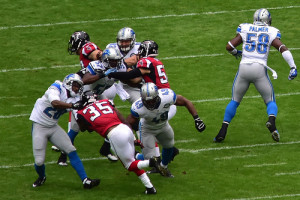
There’s a lot of big talk in sports circles these days about whether injuries are just part of the inherent risk of being an athlete. After all, athletes are often taught from an early age to toughen up and push through the pain.
But injuries can be derailing. They can cause irreparable damage to student athletes and, on the professional level, they can both hurt careers and cause major problems for teams.
There’s a movement afoot to help reduce the rate of injuries in a number of sports, and to do it using big data. The movement is taking hold in the pro world, and it’s only a matter of time before it makes its way into collegiate athletics and even high school sports.
The Big Cost of Injuries for Pro Sports
Fast Company recently reported on how big data in sports will both predict, and thus prevent injuries, and the financial driver for pro sports is a huge incentivizing factor. Brian Kamenetzky wrote, “By one estimate, teams across Major League Baseball spent $665 million last year on the salaries of banged-up guys and their replacements. NBA teams lost $358 million last season; $44 million alone by the injury-ridden Los Angeles Lakers. And in the NFL, where the average salary is about $2 million, starters missed a record 1,600 games in 2013.” When it comes to the business of pro sports, preventable injury creates operational and business inefficiency.
The Toronto Raptors is one team that’s collecting reams of data in order to better understand how to take care of its players. During practices last season, players wore an OptimEye, a gyroscope and accelerometer about the size of a cell phone, created by Catapult, a company based in Melbourne, Australia. These units collected data about the speed at which Raptors players were moving, how they accelerated and decelerated, even how they jumped. What they learned helped uncover concerns about how certain players moved, whether they were favoring one side of the body or another—in ways so subtle that coaches didn’t see it—and even identified one routine practice drill that turned out to be higher impact than coaches thought.
And while the OptimEye project is still in its infancy, it’s looking promising: The season following the initial introduction of the data-driven injury reduction program, Toronto was the NBA’s least -injured team.
Predicting Injury in Student Athletes
There are also exciting advancements being made in the form of research on sports science. One project by the University of Rochester Medical Center in New York is working with high school student athletes in the region. This summer, doctors with the University collected 3D snapshots with high-tech sensors that measured precise joint movements by hundreds of student athletes. This monitoring resulted in several 10 to 15 gigabyte digital files for each student, each file “the equivalent of downloading four feature films — in HD,” the local newspaper reported.
Researchers, including orthopedic surgeons and physicians, will combine the data with ongoing injury reports to help them fine-tune software that will eventually produce a sort of heat map. The heat map can pinpoint predictors, either in performance or form, that will help coaches see where risk of injury may be looming.
The benefit of big data infiltrating sports at the high school level can’t be overstated. After all, while it’s true that sports injuries at the professional level cost big businesses big bucks, it’s also true that the majority of people who suffer from sports injuries never make it to the professional level. Pro athletes have trainers to help nurse them back to health; high school athletes are more prone to injury and more likely to suffer from their injuries long term.
The promise of big data may not be a reality yet for the majority of high school athletics programs, but it’s likely not too far off on the horizon, and the outlook for student athletes and coaches is promising.

